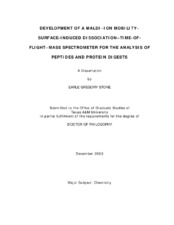| dc.contributor.advisor | Russell, David H. | |
| dc.creator | Stone, Earle Gregory | |
| dc.date.accessioned | 2004-09-30T01:42:51Z | |
| dc.date.available | 2004-09-30T01:42:51Z | |
| dc.date.created | 2003-12 | |
| dc.date.issued | 2004-09-30 | |
| dc.identifier.uri | https://hdl.handle.net/1969.1/119 | |
| dc.description.abstract | Peptide sequencing by surface-induced dissociation (SID) on a MALDI-Ion Mobility-orthogonal-TOF mass spectrometer is demonstrated. The early version of the instrument used for proof-of-concept experiments achieves a mobility resolution of approximately 20 and TOF mass resolution better than 200. Peptide sequences of four peptides from a tryptic digest of cytochrome c (ca. 1 pmol deposited) were obtained. The advantage of IM-SID-o-TOFMS is that a single experiment can be used to simultaneously measure the molecular weights of the tryptic peptide fragments (peptide mass mapping) and partial sequence analysis, (real time tandem mass spectrometry.) Optimization of the MALDI-IM-SID-o-TOF mass spectrometer for peptide sequencing is discussed. SID spectra obtained by using stainless steel, Au grids, and fluorinated self-assembled monolayers (F-SAM) on Au are compared. Optimum collision energies differ for the various surfaces. The fragmentation patterns observed for a series of peptides and protein digests using the Nd:YAG laser (355 nm) for MALDI ion formation and an FSAM surface for ion activation is compared to the fragmentation patterns observed for CID and photodissociation. The fragmentation patterns observed in all cases are strikingly similar. Photodissociation produced a greater abundance of ions resulting from side-chain cleavages. As a general rule optimized SID spectra contain fewer immonium ions than either photodissociation or CID. Evaluation of an instrument incorporating a new hybrid drift cell is discussed. Spectra for a digest of hemoglobin is compared to that acquired with an ABI 4700 TOF-TOF. The performance of the instrument is also evaluated using a micro-crystal Nd:YAG laser (355 nm) for MALDI operated at 400 Hz. Experiments were performed to determine the sensitivity and overall performance of the instrument. The reproducibility of the MS/MS spectra for gramicidin S is shown to be 94% run-to-run. The best mobility resolution obtained for a neat deposition of the dye Crystal Violet was 60 t/∆t. Sensitivity was tested with the peptide fibrinopeptide A (m/z 1537, AA sequence ADSGEGDFLAEGGGVR). Data acquired for sixty seconds with approximately sixty femtomoles deposited. Abundant [M+H]+ ions where observed as well as [M+H]+-NH3 ions. The S/N for this short run was insufficient to identify any SID fragments | en |
| dc.format.extent | 8076727 bytes | en |
| dc.format.extent | 155466 bytes | en |
| dc.format.medium | electronic | en |
| dc.format.mimetype | application/pdf | |
| dc.format.mimetype | text/plain | |
| dc.language.iso | en_US | |
| dc.publisher | Texas A&M University | |
| dc.subject | MALDI | en |
| dc.subject | IM | en |
| dc.subject | SID | en |
| dc.subject | TOF | en |
| dc.subject | MS | en |
| dc.subject | peptides | en |
| dc.subject | proteins | en |
| dc.subject | proteomics | en |
| dc.subject | simultaneous | en |
| dc.subject | PMM | en |
| dc.title | Development of a MALDI-Ion Mobility-Surface-Induced Dissociation-Time-of-flight-mass spectrometer for the analysis of peptides and proteins | en |
| dc.type | Book | en |
| dc.type | Thesis | en |
| thesis.degree.department | Chemistry | en |
| thesis.degree.discipline | Chemistry | en |
| thesis.degree.grantor | Texas A&M University | en |
| thesis.degree.name | Doctor of Philosophy | en |
| thesis.degree.level | Doctoral | en |
| dc.contributor.committeeMember | Vigh, Gyula | |
| dc.contributor.committeeMember | North, Simon W. | |
| dc.contributor.committeeMember | Scholtz, J. Martin | |
| dc.type.genre | Electronic Dissertation | en |
| dc.type.material | text | en |
| dc.format.digitalOrigin | born digital | en |


